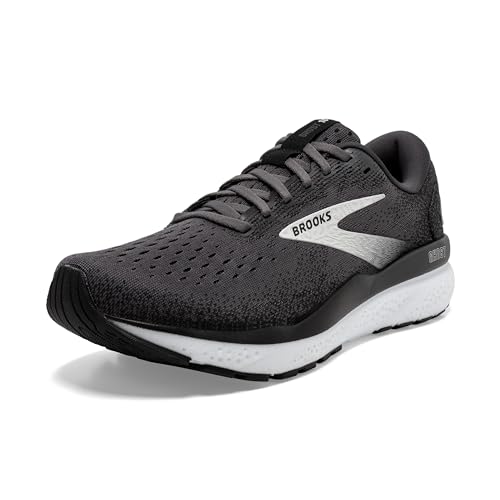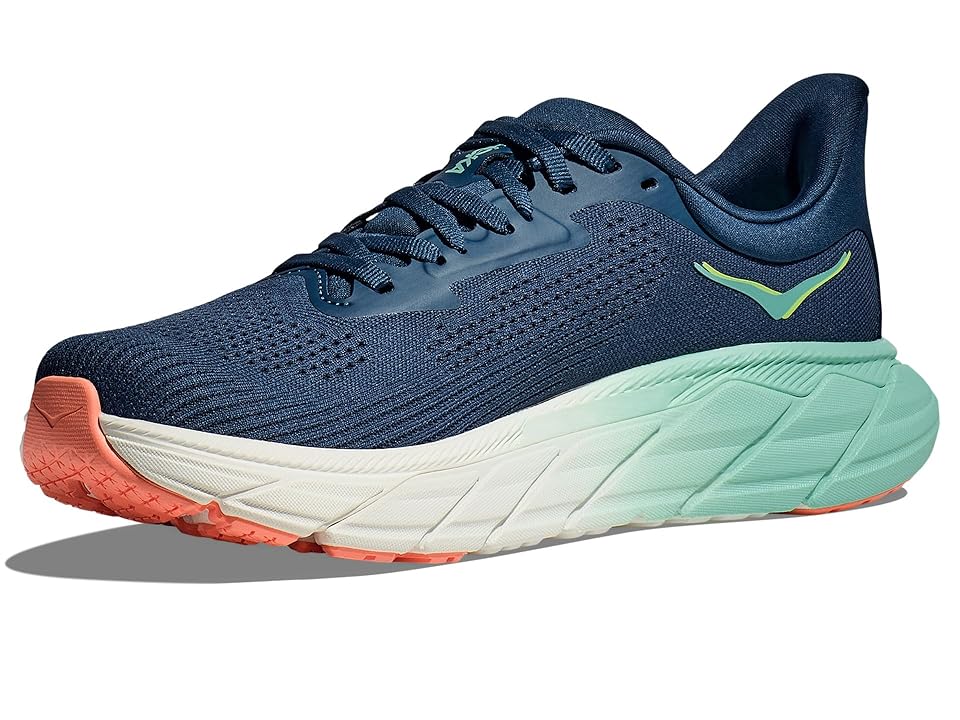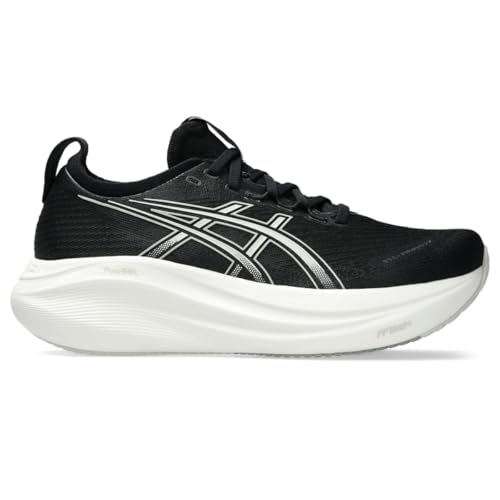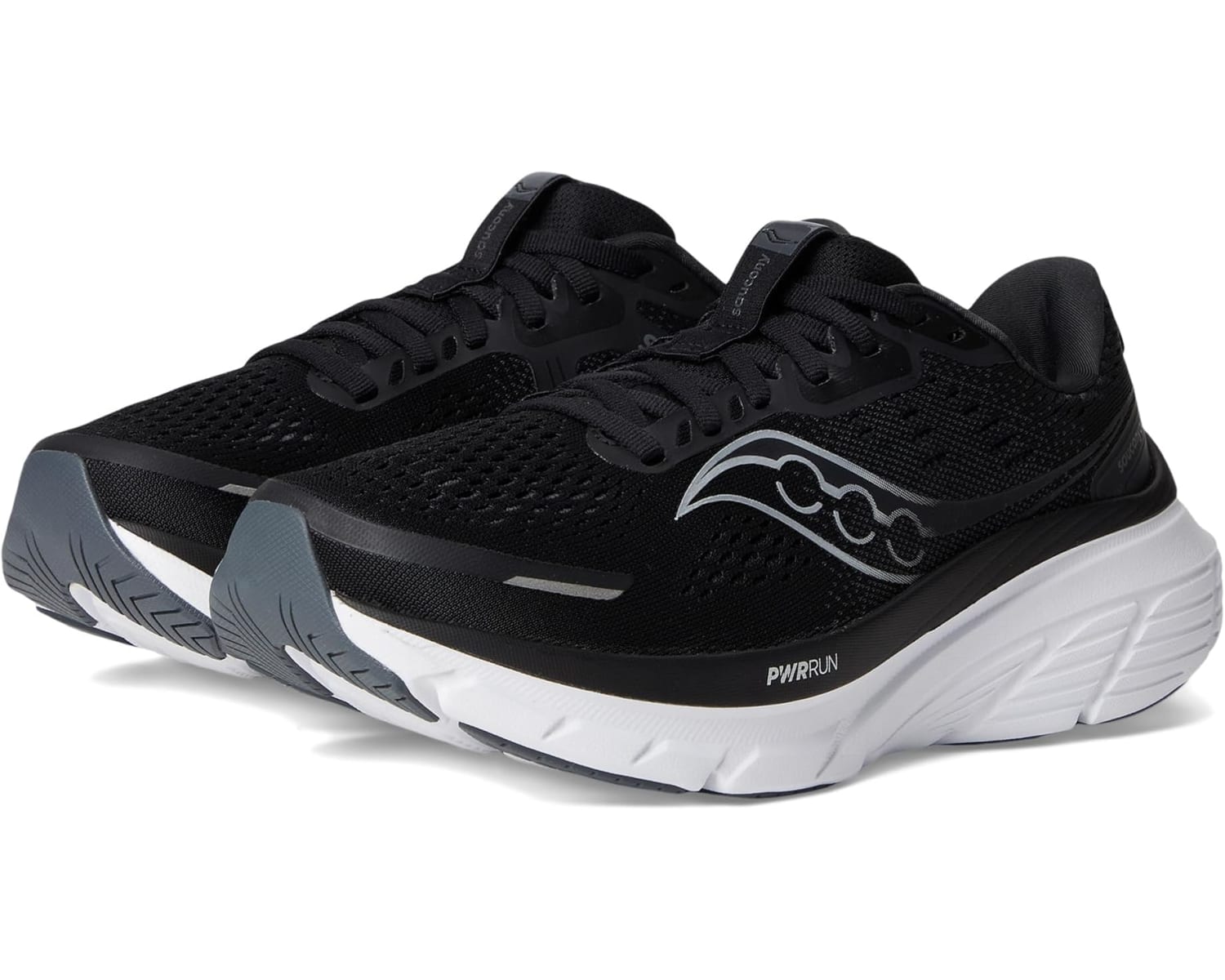You know it when you feel it — that burning, achy, uncomfortable feeling on the bottoms of your feet that starts to ruin your run halfway through. I’ve been a runner for over a decade, so I’ve experienced it plenty of times. The culprit? Wearing the wrong sneakers for my arch type.
Up until recently, I wasn’t able to define arch support or tell you what my arch type was. Many runners can’t, which is a problem — arch support is a crucial piece of the puzzle when shopping for sneakers, and it can be the difference between hitting your performance goals or not.
Below, I talked to experts about how to shop for running shoes with arch support, and why arch support is so important. Experts also explained how to figure out your arch type, and shared their favorite running sneakers for flat, high and neutral arches.
SKIP AHEAD What is arch support? | How I picked the best running shoes with arch support | The best running shoes for flat arches | The best running shoes for high arches | The best running shoes for neutral arches | How to determine your arch type | Why trust NBC Select?
Selected.
Show 1 More
Show Less
Want more from NBC Select? Sign up for our newsletter, The Selection, and shop smarter.
What is arch support?
“Arch support refers to the structural components in footwear that help maintain the natural alignment of the foot’s arch,” says Dr. Anne Sharkey, a board-certified podiatrist at North Austin Foot & Ankle Institute in Texas. It prevents excessive pronation (rolling inward) or supination (rolling outward) in the foot, which reduces the risk of pain, fatigue and injuries like plantar fasciitis and shin splints.
Your foot has multiple arches, but when people talk about arch support, they’re referring to the arch in the middle of your foot. It spans the length of your underfoot and you can see it when you look at your feet from the side. There’s three arch types — flat, high and neutral — and each one requires specific types of support from shoes. There’s also variability among arch types in terms of severity and foot structure, so some people need shoes with more prominent support than others — consult a podiatrist if you want personalized recommendations.
How I picked the best running shoes with arch support
Different arch types require different types of support. Below, I broke down what features experts recommend looking for in running sneakers for flat, high and neutral arches. If you don’t know your arch type, learn how to find it here. Also, remember that arch type is only one piece of the puzzle when it comes to shopping for running sneakers — to learn more about what you should look out for, check out our guides to the best women’s and men’s running shoes.
- Flat arches: If you have flat arches, your feet tend to overpronate, so you need stability or motion control shoes, says Rebekah Broe, the senior director of product performance for Hoka. (Ed’s note: The inclusion of products sold by Hoka in this article was made independently of Broe.) Stability shoes are best for those with moderately flat feet and motion control shoes are best for more severely flat feet. However, they both help correct misalignment by bringing your feet back into a neutral position. To prevent overpronation and keep the foot aligned, stability and motion control shoes typically have dense, firm foam on the inner side of the midfoot/arch area, a firm heel counter (the stiff part at the back of the shoe) and a wide base, says Sharkey.
- High arches: If you have high arches, your feet tend to oversupinate and they don’t absorb shock well, so they need help from extra cushioned shoes that have a somewhat flexible feel, says Broe. A thick layer of foam reduces the impact your body feels every time your feet hit the ground, and it evenly distributes your weight across the shoe to reduce strain, says Sharkey.
- Neutral arches: If you have neutral arches, your feet pronate and supinate just enough, so your shoes don’t need any specific type of support or correction, says Sharkey. Look for neutral shoes, which keep your feet comfortable and supported rather than impact how they move. These shoes usually have level cushioning, a cushioned sole and a stable base.
- APMA Seal of Acceptance: The American Podiatric Medical Association’s group of podiatrists reviews products like shoes to make sure they promote foot health and meet specific safety and quality standards. If it meets all necessary criteria, a product is given the APMA’s Seal of Acceptance. Experts say APMA-accepted shoes are always a great place to start when shopping since they’re evaluated by a third-party group of doctors.
The best arch support running shoes in 2025
To recommend the best running shoes with arch support, I rounded up podiatrists’ and NBC Select staff members’ favorite options. I separated sneakers into three categories — best for flat arches, high arches and neutral arches — and included important information about each one, including weight, material, widths, sizes and heel drop. (Heel drop is the height difference between a shoe’s heel and toe. A higher heel drop means there’s more cushioning in a shoe’s heel than its toe, and a lower heel drop means cushioning is more evenly distributed.)
All the shoes on this list are available in men’s and women’s sizes, and they all come in half and whole sizes. While shopping, you may see brands refer to a shoe’s upper, midsole and outsole. The upper covers the top of your foot, the outsole is the hard material that touches the ground and the midsole connects the upper to the outsole.
Since you won’t know how your feet feel in a pair of sneakers until you try them on, make sure you check a retailer’s return policy before you checkout, says Dr. Priya Parthasarathy, a podiatrist at the Foot & Ankle Specialists of the Mid-Atlantic.
The best running shoes for flat arches
Brooks Adrenaline GTS 24
Sharkey says Brooks’ GuideRails System is an effective stabilizing technology, which is exactly what those with flat feet need in a running shoe. It consists of two pieces of foam: a piece on the inside of your heel reduces how much your foot rolls inward, and a piece on the outside of your heel, which is firmer and higher, prevents your foot from shifting outward, according to the brand. These sneakers are made with a medium-thick layer of soft, smooth nitrogen-infused foam, and Brooks says they’re best for road running and walking.
Weight: 8.8 oz. | Material: mesh | Heel drop: 12 mm. | Sizes: women’s 5 to 13, men’s 7 to 15 | Widths: medium, wide, extra wide, narrow
Hoka Arahi 7
“The Arahi is Hoka’s most supportive sneaker for flat feet,” says Parthasarathy. It’s made with the brand’s stabilizing J-frame technology, a firm piece of J-shaped foam that wraps around the heel and extends up the inner side of the shoe to help prevent overpronation, according to the brand. The Arahi has a stretchy plush tongue that’s connected to its flat knit upper (the part of a shoe that covers the top of your foot) so it doesn’t move around when you’re running. Its EVA midsole gives it a balanced feel, and its rubber outsole adds grip. Hoka says the sneakers are best for everyday runs and walking.
Weight: 8.10 oz. | Material: mesh | Heel drop: 5 mm. | Sizes: women’s 5 to 12, men’s 7 to 15 | Widths: regular, wide
Hoka Gaviota 5
Hoka’s Gaviota sneaker, which Sharkey recommends, has a similar stabilizing system to the Arahi, but it’s made with a thicker layer of soft cushioning. Rather than a J-frame, the Gaviota has an H-frame, a firm piece of foam in the midsole (the part of a shoe that connects the upper to the outsole) that’s shaped like the number 8. It runs around the perimeter of the shoe and across the middle to prevent flat feet from overpronating, according to the brand. The shoe, which is best for everyday runs and walking, is made with a plush tongue and collar that cradles your ankle. It also has a rocker-shaped outsole that helps you smoothly move through heel-to-toe transitions.
Weight: 9.10 oz. | Material: mesh | Heel drop: 6 mm. | Sizes: women’s 5 to 12, men’s 7 to 15 | Widths: regular, wide
Asics GT-4000 4
This sneaker is another one of Sharkey’s top picks for runners with flat arches because it’s made with the brand’s Litetruss stabilizing system, which is a lightweight, gel-infused foam that effectively absorbs impact to soften your landings and offers responsive rebound, but it’s not overly cushioned. There’s a soft sockliner on the sneaker’s interior, and it has a padded tongue and collar. The GT-4000 4’s base is wide so your entire foot touches the ground.
Weight: 9.7 oz. | Material: mesh | Heel drop: 8 mm. | Sizes: women’s 5 to 12, men’s 6 to 16 | Widths: standard, wide
The best running shoes for high arches
Asics Gel-Nimbus 27
“The Gel-Nimbus 27s have a ton of cushioning and a ton of comfort in all directions,” says NBC Select reporter Harry Rabinowitz, who has medium-high arches. He likes wearing them for slow runs since they’re “heavy as a boat,” but they keep his feet cozy for miles, so the added weight is worth it. The sneakers’ foam gives them a smooth feel, and they have gel under the heel that absorbs shock and softens your landings, according to the brand. The rubber outsole also has extra grip, which gives you plenty of traction on wet or uneven roads.
Weight: 9.3 oz. | Material: mesh | Heel drop: 8 mm. | Sizes: women’s 5 to 13, men’s 6 to 16 | Widths: standard, wide, narrow
Hoka Bondi 9
“I recommend the Hoka Bondi to patients who need max cushioning, and patients that have conditions like fat pad atrophy or arthritis,” says Parthasarathy. The sneakers have a bouncy feel and a pronounced rocker-shaped outsole, as well as a 3D molded collar that’s soft against your skin and hugs your ankle. They’re also built with Hoka’s Active Foot Frame, which means they have high midsole walls that cradle your foot and prevent it from shifting on the insole while you’re running, according to the brand.
Weight: 9.30 oz. | Material: mesh | Heel drop: 5 mm. | Sizes: women’s 4 to 12, men’s 7 to 16 | Widths: regular, wide, extra wide
Hoka Clifton 9
If you have high arches but don’t love overly plush sneakers, try the Hoka Clifton 9s, says Parthasarathy.
They’re still highly cushioned, so they effectively absorb shock, but they have firmer EVA foam compared to the Hoka Bondi 9s, giving them a more balanced feel. The shoes have grippy rubber outsoles and reflective details on their heels, making your feet visible in low light. Their tongue is also connected to the upper to prevent it from moving around while you’re running. The Clifton 9s are best for everyday runs and walking, according to the brand.
Weight: 7.30 oz. | Material: mesh | Heel drop: 5 mm. | Sizes: women’s 5 to 12, men’s 7 to 16 | Widths: regular, wide
On Cloudmonster
On’s CloudTec cushioning is the most distinct part of the brand’s shoes, and the Cloudmonster has an extra-thick layer of it, which Sharkey recommends for high arches.
The bubbles you see in the midsole compress horizontally and vertically when your feet hit the ground to absorb shock and soften your landings. Then, they expand when you take off to propel you forward. The Cloudmonster is also made with On’s Speedboard, a flexible plastic plate in the midsole that acts as a spring. The shoe’s rocker shape helps you smoothly roll through strides, and it has a soft internal sock liner.
Weight: 8.11 oz. | Material: polyester | Heel drop: 6 mm. | Sizes: women’s 5 to 11, men’s 7 to 14 | Widths: regular
The best running shoes for neutral arches
Brooks Ghost 16
The Ghost is one of Brooks’ most basic running shoes, and beyond being a reliable daily trainer, I’ve also run 5Ks in them. Rabinowitz is also a fan of these sneakers. “The Ghosts are a go-to recommendation of mine for anyone who wants a comfortable walking or running shoe, but doesn’t know much about sneakers, their feet or their fitness,” he says. “They’re well-balanced for all activities, and have sufficient arch support. Plus, they come in a huge range of sizes and widths.” The sneakers have a medium-thick layer of soft, nitrogen-infused foam, as well as a flexible base. Compared to the toe area, there’s noticeably more cushioning in the heel of this shoe to soften your landings and absorb shock.
Weight: 8.5 oz. | Material: mesh | Heel drop: 12 mm. | Sizes: women’s 5 to 13, men’s 7 to 15 | Widths: standard, wide, extra wide, narrow
Brooks Glycerin 22
“For most of my recent marathon training, I wore these shoes,” says NBC Select editorial director (and four-time marathoner) Lauren Swanson. “Even with my increased weekly mileage during that training season, I didn’t feel the impact on my knees. If you’ve ever trained for a long distance race, you know how big of a deal that is.” Brooks’ Glycerin sneakers have plush, bouncy, nitrogen-infused foam, and their curved outsole helps you smoothly roll through strides. One of my favorite aspects of this shoe, which I often wear for 10Ks, is its wide base. It makes me feel balanced and stable, especially when going downhill or uphill at a fast pace.
If you’re planning to wear the Glycerins to run long distances, Swanson recommends sizing up. “I lost both of my big toenails during the Chicago Marathon because I was wearing a too-small pair of these,” she says.
Weight: 9.1 oz. | Material: mesh | Heel drop: 10 mm. | Sizes: women’s 5 to 12, men’s 7 to 15 | Widths: standard, wide, extra wide
New Balance Fresh Foam X 880v15
I always keep a pair of New Balance Fresh Foams in my closet for 3- to 4-mile recovery runs and long walks. I find them incredibly comfortable thanks to their soft, responsive cushioning, and I appreciate that they have a simple design without any frills like plates or fancy support systems. The Fresh Foams are a basic shoe that I can throw on and practically forget I’m wearing them. They also have a rocker-shaped outsole that makes for seamless heel-to-toe transitions whether I’m running on the road or treadmill.
Weight: 8.4 oz. | Material: mesh | Heel drop: 6 mm. | Sizes: women’s 5 to 12, men’s 7 to 16 | Widths: standard, wide, extra wide, narrow
Saucony Guide 18
“I’ve played the field with other sneaker brands, but I keep gravitating toward Saucony’s — it’s something about the lightness and the sole’s spring,” says Swanson. “My favorites are the Saucony Endorphins, but the Guides are a nice, cushiony option for when I need something different.” The shoes, which won an NBC Select Wellness Award, have a broad base, high side walls and foam heel collars that gently hold your feet in place, supporting their natural movement while eliminating excess motion, according to the brand. They have soft foam and a cozy interior sockliner, plus a loop on the back of the heel that helps you pull the shoes onto your feet. The loop is a small yet impactful detail I’m appreciative for.
Weight: 8.6 oz. | Material: mesh | Heel drop: 6 mm. | Sizes: women’s 5 to 12, men’s 7 to 16 | Widths: regular, wide, extra wide
How to determine your arch type
Visiting a podiatrist is often the best way to determine your arch type, says Parthasarathy, but there are a few methods you can try at home (read about all of them in our guide). The wet footprint test is often the most helpful, says Sharkey. To do it, wet the bottom of one foot, step on a piece of cardboard or colored paper, step off and examine your footprint. Here’s what to look for:
- Flat arches: If your whole foot appears in the footprint with little to no curve inward, you have flat or low arches.
- High arches: If your footprint only shows the heel and ball of your foot with a very narrow or missing section, you have high arches.
- Neutral arches: If your footprint has a moderate curve inward with about half of the arch missing from it, you have neutral or medium arches.
Using the wet footprint test, it’s typically easy to identify flat feet, but it can be challenging to distinguish between high and neutral arches, says Parthasarathy. If you try the wet footprint test and are questioning your results, make an appointment with a podiatrist.
Frequently asked questions
Why is arch support important?
Arch support is important because it ensures that your body stays in alignment while you move, says Broe. If your body isn’t in alignment, like when you overpronate or oversupinate, there’s too much pressure and stress on certain parts of your feet, which can lead to injury. Arch support evenly distributes weight across your feet to reduce fatigue, make you more comfortable, increase energy efficiency and improve your overall performance, especially if you’re doing a high-impact activity like running, says Sharkey.
How can you tell if a running shoe has arch support?
Not all shoes have built-in arch support. And while you need to look for different features depending on your arch type, there are a few ways you can tell whether a sneaker has arch support in general.
First and foremost, avoid anything thin or flat. “You should not be able to bend a shoe completely in half like a sandwich,” says Parthasarathy. That’s because shoes with arch support have a midfoot shank, a strip of material that sits between the midsole and outsole, connecting the ball and heel of your foot. The midfoot shank is usually more rigid in shoes for flat arches and more flexible in shoes for high arches, but regardless, it adds structural support and prevents your feet from twisting, says Sharkey.
Also look for a deep heel cup, cushioning in the midsole and a removable insole, says Sharkey. When you remove the insole, you should see a raised area in the shoe’s center, and when you press on it, it should feel firm. If you’re shopping online, prioritize shoes that mention “arch support” on their product pages.
Can orthotics add arch support to shoes?
Orthotics are inserts you add to your shoes, and they’re tailored to your foot shape and specific support needs, says Sharkey. There are generic options available over-the-counter, but to really be effective, you need to visit a podiatrist who can make you a custom set of orthotics.
Orthotics can add arch support to shoes, but they can’t make a bad shoe a good one, says Parthasarathy. “Just adding an orthotic to a shoe doesn’t magically make it more supportive,” she says. “The orthotic needs a good foundation.” Because of this, experts recommend focusing on finding the right shoes for your feet, and if you feel like you need even more support, talk to your podiatrist about orthotics.
Does everyone need to wear shoes with arch support?
“Arch support isn’t a universal need by any means,” says Broe. Those with flat feet, a history of foot pain and previous injuries benefit most from arch support, but many people find that it makes shoes more comfortable, helps prevent injuries and improves how they move, says Sharkey. Whether you need arch support depends on factors like your foot structure, how your feet feel while you do specific activities and underlying foot conditions, so consult your podiatrist if you’re thinking about it.
How can you tell if you’re wearing the wrong shoes for your arches?
If your feet are uncomfortable or you’re experiencing pain while wearing a pair of shoes, they’re likely not the best option for your arches. “Make sure your sneakers are comfortable right away,” says Parthasarathy. “Some people wait for the shoes to “give” or “work in” to be more comfortable, but if they’re not comfortable when you receive them, they aren’t going to get anymore comfortable, especially as your feet swell the longer you wear them.” That said, it can take time to get used to the feeling of arch support in your sneakers, so try wearing them for two hours a day before your first run in them. But your feet shouldn’t feel overly uncomfortable right away, says Parthasarathy.
Other signs that your sneakers aren’t properly supporting your arches include heel slippage, a burning sensation on the bottoms of your feet while running, arch fatigue and arch soreness, says Sharkey.
Are stability shoes and arch support shoes the same thing?
No, stability shoes and arch support shoes are not the same thing. Stability shoes are specifically designed to correct overpronation associated with flat arches, while arch support shoes can be designed for flat, high or neutral arches, says Sharkey. Overall, all stability shoes have arch support, but not all shoes with arch support are stability shoes.
How often should you replace your running shoes?
You should replace your running shoes every 300 to 500 miles, or when they feel worn out. “Don’t wear your running shoes until there are holes in them,” says Parthasarathy. “Sometimes your shoes don’t even look worn, but suddenly, you can bend them completely in half. That’s a sign you should change them.”
Meet our experts
At NBC Select, we work with experts who have specialized knowledge and authority based on relevant training and/or experience. We also ensure that all expert advice and recommendations are made independently and without undisclosed financial conflicts of interest.
- Dr. Priya Parthasarathy is a podiatrist at the Foot & Ankle Specialists of the Mid-Atlantic and a spokesperson for the American Podiatric Medical Association.
- Dr. Anne Sharkey is a board-certified podiatrist at North Austin Foot & Ankle Institute in Texas.
- Rebekah Broe is the senior director of product performance for Hoka. (Ed’s note: The inclusion of products sold by Hoka in this article was made independently of Broe.)
Why trust NBC Select?
I’m a reporter at NBC Select who has covered fitness for five years at NBC Select, including topics like women’s running shoes, women’s walking shoes, sports bras and at-home dumbbell workouts. To write this article, I interviewed three experts about running shoes with arch support and rounded up their favorite sneakers, as well as NBC Select staff picks.
Catch up on NBC Select’s in-depth coverage of tech and tools, wellness and more, and follow us on Facebook, Instagram, Twitter and TikTok to stay up to date.



